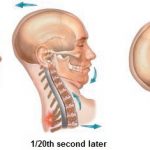MONTHLY PI ARTICLE JANUARY 2020
Basic Information about Traumatic Brain Injury

Matthew J. DeGaetano, DC and Dr. Raymond Tolmos, DC, DABCI
Certified in Personal Injury
Traumatic brain injury (TBI) is a serious public health problem in the United States. Each year, traumatic brain injuries contribute to a substantial number of deaths and cases of permanent disability. In 2014, there were approximately 2.87 million TBI-related emergency department visits, hospitalizations, and deaths in the US, including over 837,000 of these health events among children. 1
A TBI is caused by a bump, blow or jolt to the head or a penetrating head injury that disrupts the normal function of the brain. Not all blows or jolts to the head result in a TBI. The severity of a TBI may range from “mild,” i.e., a brief change in mental status or consciousness to “severe,” i.e., an extended period of unconsciousness or amnesia after the injury.
CDC’s research and programs work to prevent TBI and help people better recognize, respond.
- In 2014, there were approximately 2.5 million TBI-related ED visits in the U.S., including over 812,000 among children.
- Unintentional falls, being unintentionally struck by or against an object, and motor vehicle crashes were the most common mechanisms of injury contributing to a TBI diagnosis in the ED. These three principal mechanisms of injury accounted for 47.9%, 17.1%, and 13.2%, respectively, of all TBI-related ED visits.
- Rates of TBI-related ED visits per 100,000 population were highest among older adults aged ≥ 75 years (1,682.0), young children aged 0-4 years (1,618.6), and individuals 15-24 years (1,010.1).
Trends in Age-adjusted Rates of TBI-related Emergency Department Visits
- Age-adjusted rates of TBI-related ED visits increased 54% from 521.6 per 100,000 population in 2006 to 801.9 in 2014. An increase in age-adjusted rates occurred among nearly all of the major unintentional and intentional principal mechanism categories, including:
- a 24% increase for TBI-related ED visits as a result of motor vehicle crashes (from 85.3 to 106);
- an 80% increase for TBI-related ED visits as a result of falls (from 208.8 to 374.9);
- a 58% increase for TBI-related ED visits as a result of being struck by or against an object (from 90.8 to 143.9);
- a 60% increase for TBI-related ED visits ED visits as a result of intentional self-harm (from 0.5 to 0.8); and
- an 18% increase for TBIs as a result of assault (from 57.6 to 67.8).







